The Craziest Thing We Can Do is Nothing
663 million people on this planet don’t have access to clean water.
That’s a big number.
The hard-to-fathom kind of big.
Let’s think about it in more relatable terms. Say, a school bus. We’ve all been on a school bus, yeah? Picture that. A school bus can hold about 72 people. Are you picturing a packed school bus? Good. That’s what 72 people looks like.
Nine school buses would give you 650 people. Still with me? Nine buses is a lot. That many school buses would easily handle most weddings. Actually, your entire high school class probably wouldn’t need this many buses — and that’s if you went to a big high school.
Okay. Now this is where things really get crazy.
Are you picturing 650 kids piling out of nine school buses on the biggest field trip of all time? That’s what I’m picturing. It doesn’t really matter… just as long as you have nine school buses in your head.
Now, take those nine school buses… and multiply them by one million.
I know. It’s impossible to envision! That’s the point. 663 million is a ton of people. It’s 1/11th of our planet’s population. Twice the number of people who live in the United States.
Water issues aside, the fact that 1 out of 11 of our fellow human beings would suffer in any way is crazy!
We’ve been to the moon.
We can fly airplanes.
We order food from our phones!
It blows my mind. And that’s just the number. The other part that’s hard to comprehend is the water crisis itself.
What does it mean to say that someone struggles to find water? Where do they go? How do they collect it? What does life without a kitchen faucet look like?
I’ll give you a few examples.
Niger, West Africa
In places like the Sahel region of West Africa, where it’s often over a hundred degrees, and there aren’t many trees to provide shade, most families rely on thousand-year-old holes in the ground for their water.
Collecting from this source usually requires more than a thirty minute walk across scalding sand — and then a lot of pulling rope. It’s labor-intensive in the worst possible environment for labor, and the water you get in return is water you would only drink if it was your last possible option.
India, South Asia
While water is more accessible in India, the water sources people rely on for cooking and drinking are usually the same ones they use for bathing and going to the bathroom.
Unhygienic living conditions like this make for highly-contaminated water and an increase in water-borne diseases and malnutrition. It fuels a cycle of poverty (if you become sick, you can’t work; you’re taking on debt while not earning income) that hundreds of millions of people can’t escape.
Ethiopia, East Africa
In rural Ethiopia, water is so scarce that many families survive on less than two gallons per day and walk up to four hours to find it.
Their water sources, often nearly-dry river beds or muddy holes that communities have dug together, offer water that sometimes needs to be poured through cloth to filter out leeches and debris.
This is a crisis. Even if it were 1 million people, it would be a crisis. But it’s not 1 million. It’s 663 million.
663 million people on our planet drink dirty and dangerous water. And they don’t just drink it — they work for it! They invest hours every day. And not only does it keep them out of school, or take up time that they could be using to earn money for their family, it also kills them.
That’s not an exaggeration.
Diseases from unsafe water and lack of basic sanitation kill more people every year than all forms of violence, including war.
But there’s good news too (finally, right?).
All of this is solvable.
663 million is a massive number. But ten years ago, it was 1.1 billion. Last year it was 748 million. We, as a planet, have nearly cut the water crisis in half. The world is getting better!
And the world is getting better for it too.
Families go from having limited access to dirty water to unlimited access to clean water.
They instantly become healthier not just because of the water they’re drinking, but because they get to bathe and wash their clothes regularly. They can wash their hands!
Healthier kids spend more time in school. Healthier men and women earn more money for their families. It’s exponential.
Better opportunities.
Stronger economies.
Future leaders.
Written By: Tyler Riewer
Illustrated By: Garrett DeRossett
Photos By: Jeremy Snell, Joey L, & Tyler Riewer
